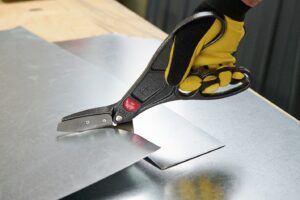Hand tools are essential for trade professionals in many fields, such as HVAC, roofing, siding, electrical, and more. However, if they are not used correctly or are of poor quality, they can also pose risks of injury and fatigue.
The Hand Tool Institute (HTI) has named May Hand Tool Safety Month. During this month, Malco Tools and many other organizations and individuals are promoting awareness and safe practices when using hand tools. Follow proper safety guidelines, use appropriate PPE, prevent accidents, and protect your hands!
Malco tools are more than just tools; they embody our unwavering commitment to safety and durability.

It Prevents Injuries and Accidents
Hand tools can cause injuries if they are not used correctly or are defective. For example, using a dull blade can increase the risk of slipping and cutting yourself, or using a tool with a frayed cord can expose you to electric hazards. These injuries can result in lost work time, medical expenses, and legal liabilities. By understanding and practicing hand tool safety, you’re proactively preventing these accidents and protecting yourself and your work.
It Improves Efficiency and Quality
Safe and ergonomic hand tools enhance your work and contribute to your well-being. They can boost your productivity by alleviating physical strain and fatigue that hamper your performance and precision. For instance, a tool with a comfortable grip, such as our Hand Seamers, can enable you to exert more force and accuracy. Hand tool safety can also prolong the lifespan and performance of your tools, as they are less prone to damage or malfunction.
It Enhances Your Reputation and Customer Satisfaction
Hand tool safety can also reflect your professionalism and competence as a trade pro, showing that you care about your work and health. Customers are more likely to trust and recommend you if they see that you use safe, quality tools and follow your industry’s best practices and standards. Hand tool safety can also help you avoid costly mistakes and rework that can damage your reputation and customer satisfaction.
Choose Tools That are Appropriate for the Task and the Material
For example, use a snip designed for cutting metal, not plastic or wood. Use a tool that is the right size and shape for the workpiece and the work area. Avoid using tools that are too big, small, or heavy for the job.
Choose Tools That are in Good Condition and Well-maintained
Inspect your tools before and after each use, looking for any signs of damage, wear, or malfunction. For example, check the blades for sharpness, the handles for cracks, and the cords for frays. Clean, lubricate, sharpen your tools as needed, and store them in a dry and secure place. Replace or repair any defective or unsafe tools. Find your nearest authorized Malco dealer when it’s time to upgrade any tools in your set.
Choose Tools That are Ergonomic and Comfortable
Look for tools with features that reduce hand fatigue and increase comfort and control. Malco’s lightweight and ergonomic Andy™ Offset Snips are a great example. This tool allows trade pros to make longer, tighter, higher-quality straight and left-curve cuts in many types of materials. The ergonomic offset handle provides a safer and more comfortable angle for cutting to reduce hand fatigue.
Malco’s RedLine Ergonomic Handles
One of the best ways to ensure hand tool safety and comfort is to use tools that feature Malco’s RedLine Ergonomic Handles. These patented handles reduce hand fatigue and increase comfort and control. They offer non-slip handle grip contours, spring handle actuation, and a thumb-operated handle latch. The tool’s engineered handle opening complements the natural power stroke of any user’s hand.
Malco’s RedLine Ergonomic Handles are featured in many of our hand tools, such as crimpers, notchers, and seamers. These tools are ideal for trade pros who work with sheet metal, ductwork, vinyl siding, fencing, and other materials. You can find these tools and more at malcotools.com.